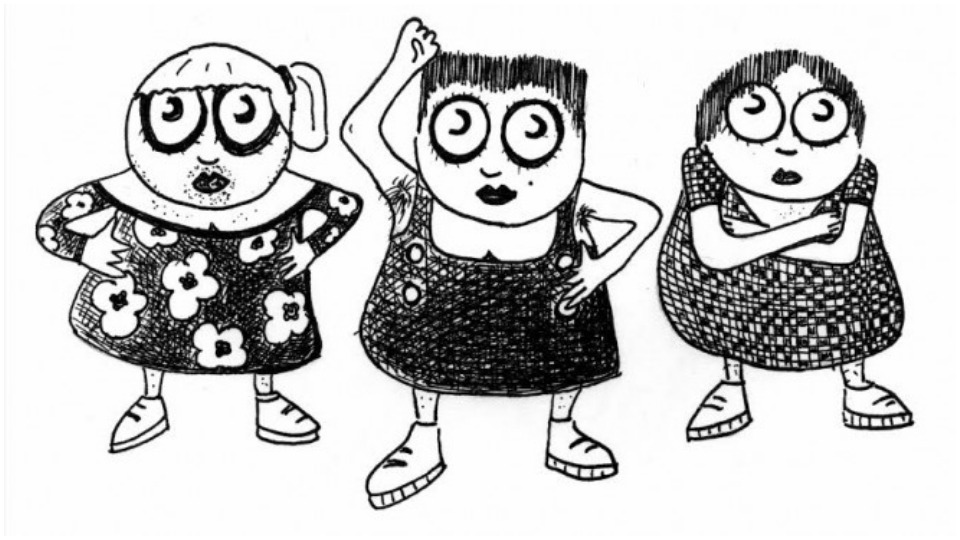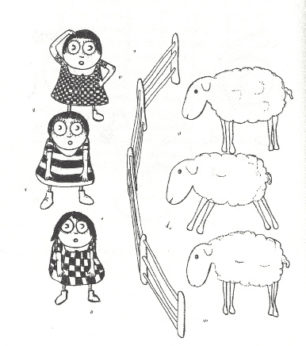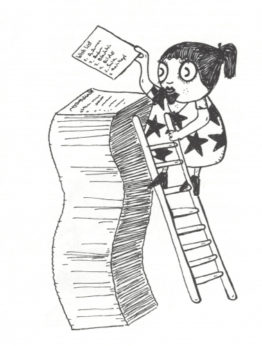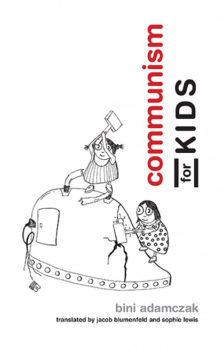

This short book (101 pages with lots of illustrations, presumably by the author) in a pocket-sized edition is ostensibly aimed at teaching young readers to: 1) critique capitalism for its many-faceted injustices and 2) conceive of a humanistic communism true to some of the founders’ original stateless principles.
“Before attempting to show that communism might be feasible, one has to first present it as conceivable. Communism needs to be imaginable in order to be desirable.”
Along the way toward giving readers permission to imagine, Ms. Bini Adamczak picks apart various topics that commie-curious kids might be wondering about, such as:
What is communism? “Communism names the society that gets rid of all the evils people suffer today in our society under capitalism.” But “even if communism is a good remedy, it’s no cure-all. It’s only a remedy for the evils caused by capitalism.” The author sets the stage, although it’s a somewhat shaky platform, for a later dismissal of the 20th-century socialist experiment as utter failure.
What is capitalism? “Capitalism exists today all over the world, and it’s called capitalism because capital rules. This isn’t the same as saying that capitalists rule, or that the capitalist class rules. In capitalism, there are certainly people who have more power than others, but there isn’t a queen who sits on the throne high above society and commands everybody. So if people no longer rule over society, who does? The answer may sound a little strange. Things do.” Props to the author here for trying to introduce abstract concepts such as the “fetish” of things (although she doesn’t use that term), yet by depersonalizing the concept of “rule,” does she thereby ghost the Waltons, the Koch Brothers, the Mellons, Rockefellers, and the Trump Cabinet?
How did capitalism arise? “Capitalism first developed in England around five hundred years ago. At that time, feudalism still ruled, which means there were queens, princesses, and many maids,” whose power would be challenged by the rising merchant and slavetrading class. Odd that Adamczak feminizes monarchism: The “princesses” kicked the peasants off their land to create a more monetized society in which “those who don’t happen to own a factory have been forced to sell themselves” (though there’s no explicit explanation of the theory of surplus value). On the one hand, I suppose it’s a positive that she introduces some role reversal to show that women can wield authority; yet I wonder if our “commie-curious kids” will now, quite ahistorically, start seeing females as the wicked witches of Western capitalism?

What is work? You show up at the gate, and the clerk says, “The factory…will give you enough money to eat and drink and pay your rent, and also go to the movies twice a week. But in exchange, you have to do pretty much everything the factory tells you to do for as long as you’re there.” As in many children’s books, objects become anthropomorphized into living, conscious, articulate creatures. “The factories are always talking about the same three things. They tell us how we should produce, what we should produce, and how much we should produce.” Such as: “a hundred nails hammered per hour, or one entire apartment’s laundry pressed, or five pages written daily on the computer” (glad to see intellectual work recognized here). The factory doesn’t care about people: It makes and sells stuff, and takes that stuff out to market.
What is the market? Here Adamczak speaks of not only the market for products. “At the labor market, there are lots of different people on sale who have already been produced ready-made in other special factories, like the school and family factories.” She then gets into competition (using the example of factories that manufacture irons), bankruptcy, and crisis. “Before, the workers from both factories were able to go to the movies twice a week. Now, one group of workers can only go to the movies once a week while the other group can’t go at all. But there’s something else. People who can’t afford to go to the movies also can’t afford to shop for irons. And that leads to a big problem.”
What is crisis? Now workers are unemployed, bored, and hungry; and the closed factories are loaded with irons no one wants any more. The workers figure out that capitalism was the problem and light on communism as the solution. “But it’s not so simple. Since true communism has never existed in the entire history of humankind, no one has any clue what it looks like. What the people do have are various ideas of what a communist society should look like.” It’s curious that having delineated in cartoon form the various stages of history that led up to present-day capitalism, the author wants to leap from today’s crisis right to “true communism,” which would seem to negate the laws of dialectical and historical materialism.
Six trials
In a series of six trials, the people devise systems for realizing their communist dream. The first is everyone putting all their money in the same pot (“that is, the state”), which doles out both work and goods. “But ‘just a minute!’ someone interrupts. ‘Working in the factory isn’t fun at all! It’s exactly the same dumb work as before.’”
The second trial involves worker-owned plants where “they hang little black-and-red flags out of the factory’s windows.” But when they take their irons to market, they find another factory is selling irons cheaper, so they have to start laying people off and choosing a boss “who can tell us what to do next.” They see that under this system, too, they “have no control over what we make or how much. That’s not how we imagined it.”

In the third trial, the workers devise an administrative state with central planning. But the administrators are unable to keep up with the people’s wish list unless they oblige people “to work harder and longer in order to make enough stuff to fulfill all the wish lists. Meanwhile, the wish lists grow longer and longer.” “Before you know it, work has become as exhausting and boring as it was before, under capitalism.” The administrators “grow richer and more powerful, while the factory people work longer and harder only to see their wishes fulfilled less and less.” Clearly, the object of this criticism is the 20th-century system of “actually existing socialism,” a term which of course served to excuse a lot of abuses, but in this antiseptic hothouse “trial” no account is made of war or military threat that in large part accounted for less butter and more guns.
On to trial number four: “Let’s get rid of work…. Let the machines do the work for us!” But the people become lazy, bored, antisocial, and unhappy. “And nothing remains of the new and extraordinary skills they developed while doing everything for themselves in the factories.” So much for the technocratic revolution!
In trial five, a strict egalitarianism is conceived but people are different: They have different needs, and some work harder and faster than others for the things. They “grab hammers and smash everything to little pieces.” Bereft of things, they are left to gathering wild berries. So much for nihilism!
Finally, in the sixth trial, the whole world is hooked up to the internet and the discussion flowers. In the end, they conclude that “nobody should work in a single factory anymore. Everyone should be able to do everything and live everywhere.” They agree that it’s a challenging, but fruitful conversation to have whether we decide what to make and then who should make it, or whether it’s the other way around, how much we want to work and what needs we must meet.
A reader with some background in socialist thinking will readily identify this hopeful, optimistic conclusion with some skepticism, smacking as it does of the early “utopians” with their colonies and artisanal workshops, their sometimes mystical or religious underpinnings, their fanciful idealism, and frankly, their naïve view of humanity. At the same time, the questions raised are not incidental, and if not realizable immediately or foreseeably any time in the very near future, are still worth asking as we try to build a new future.
Communist desire
An epilogue to the fairytale, called “communist desire,” expands historical interpretation and communism’s visionary promise in the author’s own scholarly voice clearly in no way directed at a children’s readership. After the fall of the Soviet Union, and after 9/11, “instead of hope for a better future, there’s only a totalizing fear of a worsening present,” she writes, seemingly dismissive of movements in China, Vietnam, and Latin America that, if hardly utopian, have nonetheless raised a billion or more people to precisely that “hope for a better future” that Adamczak finds so completely absent in the world.
We must create “communist desire…capable of jamming images of a better world into every fracture of daily life, from subway rides to service jobs to global poverty. In every moment of social suffering, this desired demands a better way of life.”
Today, there are different and competing concepts of communism, some of them recapitulating precisely the elements of alienation of labor on which the main body of the book extrapolates. Most systems still comprise methods of organizing labor, production, and consumption in ways that closely resemble capitalist norms.
Yet again, Adamczak would presume to yank such countries as Cuba, China, Vietnam, and Laos out of their historical contexts going back thousands of years, expecting that once “communist” all would or could suddenly turn from black-and-white to glorious technicolor, and also ignoring that though led by communist parties, those countries never claimed to be communist, only socialist, in a highly imperfect world, with future communist aspirations.
This is not to say that the author despairs from the place we occupy right now. “Rather, our only possible standpoint lies in the future. The hope is that the absurdity and unnecessary brutality of capitalist society will leap out to the people of future generations, the same way that the binary gender system or flatness of the earth seems crazy to us today.” She quotes philosopher Theodor Adorno to the effect that “Thought must comprehend even its own impossibility for the sake of the possible.”
“A transformation is a production of the future,” Adamczak writes, “a realization of a possibility as well as the creation and exclusion of possibilities. If the redemptive future negates the present suffering, then shouldn’t the future and the idea of the future be constantly in flux?” In that sense, she acknowledges, communist desire of a hundred years ago might not resemble today’s, nor today’s tomorrow’s. As desire becomes reinvented, one thing remains constant: “the desire that misery finally comes to an end.”
Setting her work (originally published in 2004) in the context of a new generation of rebellion in the first decades of the 21st century, she remarks upon the end of the “end of history” idea that communism was effectively buried and the future was inevitably global neoliberal capitalist. In her last paragraph she writes:
 “The ‘eternal present’ of capital has ended, for now. Under conditions of crisis, there is no mere defense of the status quo. It is not enough to prevent the worst and get the bad. The most effective protection against the return of fascism is not to preserve the world it ostensibly fights, but to create a different world. The politics of separation can only be challenged by a politics of solidarity. For the first time in ages, history is open once again—for suggestions.”
“The ‘eternal present’ of capital has ended, for now. Under conditions of crisis, there is no mere defense of the status quo. It is not enough to prevent the worst and get the bad. The most effective protection against the return of fascism is not to preserve the world it ostensibly fights, but to create a different world. The politics of separation can only be challenged by a politics of solidarity. For the first time in ages, history is open once again—for suggestions.”
Communism for Kids
By Bini Adamczak
Translated by Jacob Blumenfeld and Sophie Lewis
Cambridge, Mass.: The MIT Press, 2017
ISBN: 978-0-262-53335-5










